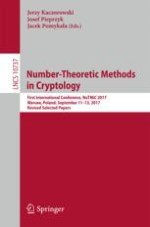2018 | Buch
Number-Theoretic Methods in Cryptology
First International Conference, NuTMiC 2017, Warsaw, Poland, September 11-13, 2017, Revised Selected Papers
herausgegeben von: Prof. Dr. Jerzy Kaczorowski, Josef Pieprzyk, Jacek Pomykała
Verlag: Springer International Publishing
Buchreihe : Lecture Notes in Computer Science
